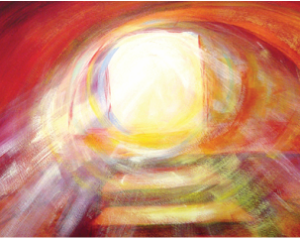Any reading of the New Testament, particularly regarding the resurrection, stands on two levels of literary interpretation. The first level relies on the literal sense of the word, while the second relies on the metaphorical. My interpretation of the resurrection of the body of Christ emphasizes the metaphorical.
1) The literal: the visible, the physical and the material
2) The metaphorical: the obscured, the spiritual and the metaphysical
 The word church has two meanings. One sense reflects the visible, physical and material representation of a building, a temple or a place of worship. Whereas, the second interpretation of the word means the spiritual and metaphysical assembly of believers; a congregation.
The word church has two meanings. One sense reflects the visible, physical and material representation of a building, a temple or a place of worship. Whereas, the second interpretation of the word means the spiritual and metaphysical assembly of believers; a congregation.
The same goes for body. One meaning of the word represents the visible and physical anatomy of a human being; the flesh. The second, a more spiritual concept, means a group of people or entities gathered together as one single gathering.
In his encyclical letter, Mystici Corporis, Pope Pius XII wrote, “The Church IS the Body of Christ”. He further explained:
We come to that part of Our explanation in which We desire to make clear why the Body of Christ, which is the Church, should be called mystical… in the mystical Body the mutual union, though intrinsic, links the members by a bond which leaves to each the complete enjoyment of his own personality.
In other words, the notion of the Body of Christ includes each individual member in ONE spiritual, mystical unity. The Body of Christ, the Church, is the congregation of all the living faithful comprised in it.
The Metaphorical
The synoptic Gospels share a similar chronology of the last supper, the passion and resurrection. The accounts use the same metaphors to describe Jesus’ central message of his body. During the last supper, Jesus breaks the bread, drinks the wine, shares it with his disciples and says:
Take and eat; this is my body
Drink from it; this is my blood (Matt 26-28)
Jesus holding the bread in his hands saying; “this is my body…” is in terms of literary criticism metaphorical.
A metaphor is a figure of speech that inaugurates a shift away from the normal use of language. It is an exile from a former way of being in respect of communication, community and communion. The metaphor is used as a code to reveal the spiritual meaning of the Word. And implies a new symbolic reality in terms of religious ritual practices.
The loaf of bread is a metaphor of Jesus’ body. The breaking of the loaf of bread and sharing it with all the disciples constitutes parts that makes up one body. This institutes a living church (assembly) comprised of Jesus and his disciples. Finally, Jesus gave the commandment to do the same in his memory and preach his message to the world.
The same goes for the sharing the cup of wine that becomes the blood of the new covenant. Wine is a metaphor for Jesus’ blood sacrificed for Church’s resurrection.
Thus, the Good News proclaims that all are welcome to partake in the breaking and eating the bread in remembrance of Jesus Christ.
In the same way, after supper he took the cup, saying, “This cup is the new covenant in my blood; do this, whenever you drink it, in remembrance of me. Cor 11:25
Although the Gospel of John does not have a last supper scene, he does confirm the importance of the metaphor to understand the Good News.
I am the gate ─ door (John 10:9)
I am the way (John 14:6)
Jesus told his disciple Simon that he would be known as Peter (literally meaning rock) on which he would build his living community, his Church. This is an additional confirmation of an allegorical allusion that the metaphor holds a vital role in understanding the meaning of the Word.
You are Peter, and on this rock I will build my Church. (Matt 16:18)
God works in mysterious ways. The unraveling history of Jesus Christ’s Resurrected Body is revealed by the visible expansion of the Church which began with faith in the Word. Hence, without the need of a central government, or the collection of taxes and without the help of a standing army, Christianity took over the Holy Roman Empire and spread of the Good News throughout the world.


